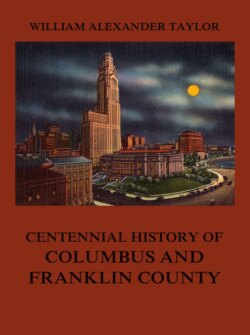Читать книгу Centennial History of Columbus and Franklin County - William Alexander Taylor - Страница 11
На сайте Литреса книга снята с продажи.
Оглавление
The First Sale of Lots.
The first sale of lots in the city of Columbus began on June 18, 1812, and continued an a public vendue for three days, and after that they were disposed of at private sale.
The First State Home.
the old state house was built on the southwest corner of the Capitol Square in 1814. A fuller description and an account of its destruction by fire appears elsewhere.
The First Stores.
The first stores in Columbus, say from 1812 to 1818, were opened in the following order and conducted or "kept" by the following persons, respectively: Belonging to the Worthington Manufacturing Company, kept by Joel Buttles in a small brick building on west end of lot later covered by the Broadway Exchange. Belonging to McLene & Green, in a log cabin on Rich street. Three connected cabins, kept as a bakery and place of entertainment by Christian Heyl.
The First Taverns.
The first tavern was kept by Volney Payne in a two-story brick on the lot afterward occupied by the Johnston building, Volney Payne, John Collett, John Mcllvain, Robert Russell and James Robinson, respectively, conducted this house until 1844. In 1844 Daniel Kooser opened a tavern on Front street, south of State, and a Mr. McCollum opened one on Front, north of Broadway.
The Franklin, afterward called the Nagle, was kept by Christian Heyl, and several smaller hotels, incident to a growing town of that day, were kept, but without special designation.
Later, in 1815, David S. Broderick opened the "Columbus Inn" in a large frame building on the corner of Town and High. In 1816 James B. Gardiner opened a tavern on Friend (Main) street, just west of High. Mr. Broderick having retired from the hotel business in 1818, Gardiner took charge of the stand, corner of Town and High, and called it "The Rose Tree," with the Biblical quotation: "The wilderness shall blossom as the rose." The stand for a time was known as the "Franklin House" and the "City House," and possibly was otherwise designated. When Mr. Gardiner removed from Friend (Main) street to take charge of "The Rose Tree," (Judge) Jarvis Pike took charge of the former stand and renamed it "The Yankee Tavern."
About 1815-16 there was a somewhat famous "place" yclept "The War Office," where, between drinking and carousing and quarreling and fighting, Squire Shields, who was among the first justices of the peace, was enabled to run a pretty heavy police docket at times.
The First School and School Teachers.
The first school taught in Columbus was in a cabin that stood on the public square (teacher's name not now known); then succeeded as teachers, in 1814-15, and so on, Uriah Case, John Peoples, W. T. Martin, a Mr. Whitehill, Joseph Olds (afterward a distinguished lawyer and member of congress), Dr. Peleg Sisson (while acquiring his profession), Samuel Bigger (afterward governor of Indiana), Rudolph Dickinson (for a number of years a member of the board of public works and member of Congress), Daniel Bigelow, Orange Davis, a Mr. Christie, Rev. Mr. Labare, Cyrus Parker, H. N. Hubbell. Andrew Williams, and a number of others not now recollected, who were all teachers of common subscription schools in Columbus before the introduction of the present free school system.
